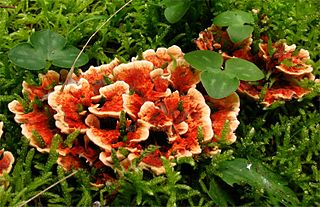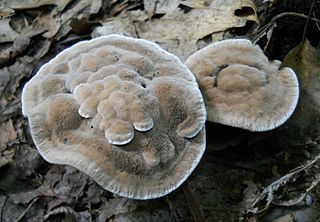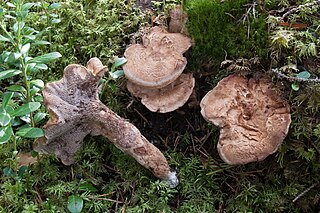
Hydnellum is a genus of tooth fungi in the family Bankeraceae. Widely distributed in the Northern Hemisphere, the genus contains around 40 species. The fruitbodies of its members grow by slowly enveloping nearby bits of grass and vegetation. There is great variability in the form of Hydnellum fruitbodies, which are greatly influenced by environmental conditions such as rainfall and humidity, drying winds, and temperature. They are too tough and woody to eat comfortably. Several species have become the focus of increasing conservation concern following widespread declines in abundance.

Phellodon is a genus of tooth fungi in the family Bankeraceae. Species have small- to medium-sized fruitbodies with white spines on the underside from which spores are released. All Phellodon have a short stalk or stipe, and so the genus falls into the group known as stipitate hydnoid fungi. The tough and leathery flesh usually has a pleasant, fragrant odor, and develops a cork-like texture when dry. Neighboring fruitbodies can fuse, sometimes producing large mats of joined caps. Phellodon species produce a white spore print, while the individual spores are roughly spherical to ellipsoid in shape, with spiny surfaces.

Sarcodon is a genus of fungi in the family Bankeraceae, which is part of the order Thelephorales, known for its almost universal ectomycorrhizal ecology. The genus owes its name to the presence of teeth-like spines on the hymenophore, from ancient Greek; sarco = flesh and odon = tooth. For this reason they are commonly called "tooth fungi", or "Hydnoid fungi".

The hydnoid fungi are a group of fungi in the Basidiomycota with basidiocarps producing spores on pendant, tooth-like or spine-like projections. They are colloquially called tooth fungi. Originally such fungi were referred to the genus Hydnum, but it is now known that not all hydnoid species are closely related.

Hydnellum fuscoindicum, commonly known as the violet hedgehog, is a species of tooth fungus in the genus Hydnellum. It is found in the Pacific Northwest in moss around western hemlocks. It produces fruit bodies with a violet-black cap, violet flesh, and violet spines on the cap underside. The odor and taste are very farinaceous. The fungus was first described by Kenneth A. Harrison in 1964 as a species of Hydnum, then transferred to Sarcodon in 1967 by Rudolph Arnold Maas Geesteranus. He placed this species in section Violacei of Sarcodon, along with H. fuligineoviolaceum and H. joeides.

Hydnellum auratile is a tooth fungus in the family Bankeraceae. Fruit bodies of the fungus consist of closely grouped, funnel-shaped caps up to 5 cm (2.0 in) in diameter. The caps are initially bright orange with a white rim, and have a felt-like surface. On the cap underside, the hymenium has hanging orange spines with whitish tips. These spines extend a ways down the length of the short stipe. The flesh is orange in both the cap and stipe. In mass, the spores are brown. Microscopically, they measure 4–5 by 3.5–4.5 μm and have short, rounded tubercles on the surface. The widespread Hydnellum aurantiacum is a close lookalike, but can be distinguished by having a white to buff cap, dull orange to brown flesh, and white spines.
Hydnellum nigellum is a tooth fungus in the family Bankeraceae. Found in Nova Scotia, Canada, where it grows under spruce, it was described as new to science in 1964 by Canadian mycologist Kenneth A. Harrison. The fruitbodies of this fungus are small, measuring 3–6 cm (1.2–2.4 in) in diameter, and black.

Hydnellum spongiosipes, commonly known as the velvet tooth, is a tooth fungus in the family Bankeraceae. It is found in Europe and North America. In Switzerland, it is considered a vulnerable species.

Hydnellum glaucopus is a species of tooth fungus in the family Bankeraceae. Found in Europe, it was described as new to science in 1969 by mycologists Rudolph Arnold Maas Geesteranus and John Axel Nannfeldt. Fruit bodies contain cyathane diterpenes called glaucopins that have anti-inflammatory activity in laboratory tests. It is considered vulnerable in Switzerland.
Hydnellum lundellii is a species of tooth fungus in the family Bankeraceae. Found in Europe, it was described as new to science in 1969 by mycologists Rudolph Arnold Maas Geesteranus and John Axel Nannfeldt.

Hydnellum fuligineoviolaceum is a species of tooth fungus in the family Bankeraceae. It was originally described in 1874 by Hungarian mycologist Károly Kalchbrenner as Hydnum fuligineoviolaceum, in Elias Fries's work Hymenomycetes europaei. Narcisse Théophile Patouillard transferred it to the genus Sarcodon in 1900. Sarcodon talpa, published by Rudolph Arnold Maas Geesteranus in 1967, is a synonym.
Sarcodon aglaosoma is a species of tooth fungus in the family Bankeraceae. Found in Papua New Guinea, it was described as new to science in 1976 by Dutch mycologist Rudolph Arnold Maas Geesteranus. It is quite similar to H. joeides and S. ianthinus, both also from New Guinea.
Sarcodon bubalinus is a European species of tooth fungus in the family Bankeraceae. First described by Christian Hendrik Persoon in 1825 as Hydnum bubalinum, it was transferred to the genus Sarcodon by Rudolph Arnold Maas Geesteranus in 1956.
Hydnellum lepidum is a species of tooth fungus in the family Bankeraceae. Found in Europe, it was described as new to science in 1975 by Dutch mycologist Rudolph Arnold Maas Geesteranus.
Sarcodon wrightii is a species of tooth fungus in the family Bankeraceae. It was first described in 1860 by Miles Berkeley and Moses Ashley Curtis as Hydnum wrightii. They were sent a specimen collected from Japan as part of the North Pacific Exploring and Surveying Expedition (1853–56). Rudolph Arnold Maas Geesteranus transferred it to the genus Sarcodon in 1967. The fungus produces roughly spherical spores that are tuberculate and measure 5.5–6.5 by 4.5–5.5 μm.

Hydnellum joeides is a species of tooth fungus in the family Bankeraceae.

Sarcodon thwaitesii is a species of tooth fungus in the family Bankeraceae. It is found in Asia, Europe, and New Zealand, where it fruits on the ground in mixed forest.

Sarcodon leucopus is a species of tooth fungus in the family Bankeraceae. Found in Asia and Europe, it was described as new to science in 1825 by Christian Hendrik Persoon. Mycologists Rudolph Arnold Maas Geesteranus and John Axel Nannfeldt transferred it to the genus Sarcodon in 1969. Fruit bodies of the fungus have flattened to slightly depressed caps up to 20 cm (8 in) in diameter. The surface texture, initially finely felt-like, later cracks to form shiny scales. Its color is pale purplish-brown to dark brown. The stipe measures 4–8 cm (1.6–3.1 in) long by 2–6 cm (0.8–2.4 in) thick. Spines on the cap underside are up to 15 mm long and about 1 mm thick. The flesh has a disagreeable odor, and a bitter taste. Spores are roughly spherical, typically measuring 7.2–7.9 by 4.5–5.6 µm. The fungus is considered endangered in Switzerland.

Hydnellum fennicum is a species of tooth fungus in the family Bankeraceae. It was originally described by Petter Karsten in 1882 as a variety of Sarcodon scabrosus. Karsten promoted it to a distinct species in 1887. It is considered critically endangered in Switzerland. It is inedible.

Hydnellum versipelle is a species of tooth fungus in the family Bankeraceae. It was originally described by Elias Fries in 1861 as Hydnum versipelle. Taisiya Lvovna Nikolayeva transferred it to the genus Sarcodon in 1961. Hydnum crassum, published by Kenneth A. Harrison in 1961, is a synonym. The species is found in Europe and North America.














